Find the craters named for the three astronauts who flew the first manned mission to land on the Moon.
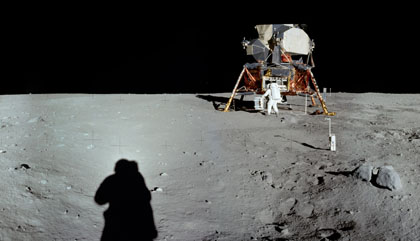
NASA
In the mood for a lunar adventure? The 50th anniversary of the Apollo 11 moon landing is this Saturday, July 20. How about a visit to the craters named for the mission's three astronauts — Neil Armstrong, Buzz Aldrin and Michael Collins? The trio make a neat little row in the Sea of Tranquillity not far from the Apollo 11 landing site.
You can drop by on July 20th — the day of the anniversary — or wait and get a better view on July 21st and 22nd, when the lunar terminator passes a short distance east of the three. Slanted sunlight will highlight their tiny, bowl-like shapes and shadowed interiors. The Moon will be a waning gibbous at the time, so it won't climb high enough for a good look until around 2 a.m. For most of us that's a tough time to be up, but there are other options.
You can arise around 5 or 5:30 a.m., when the Moon reaches its peak altitude, or hold off until the next period of visibility, which occurs on Aug. 6th and 7th, when the moon will be in first-quarter phase and conveniently placed in the evening sky. Check the list below for other times. I will say that one advantage of morning viewing is that the moon will be much higher in the pre-dawn sky compared to post-dusk viewing.
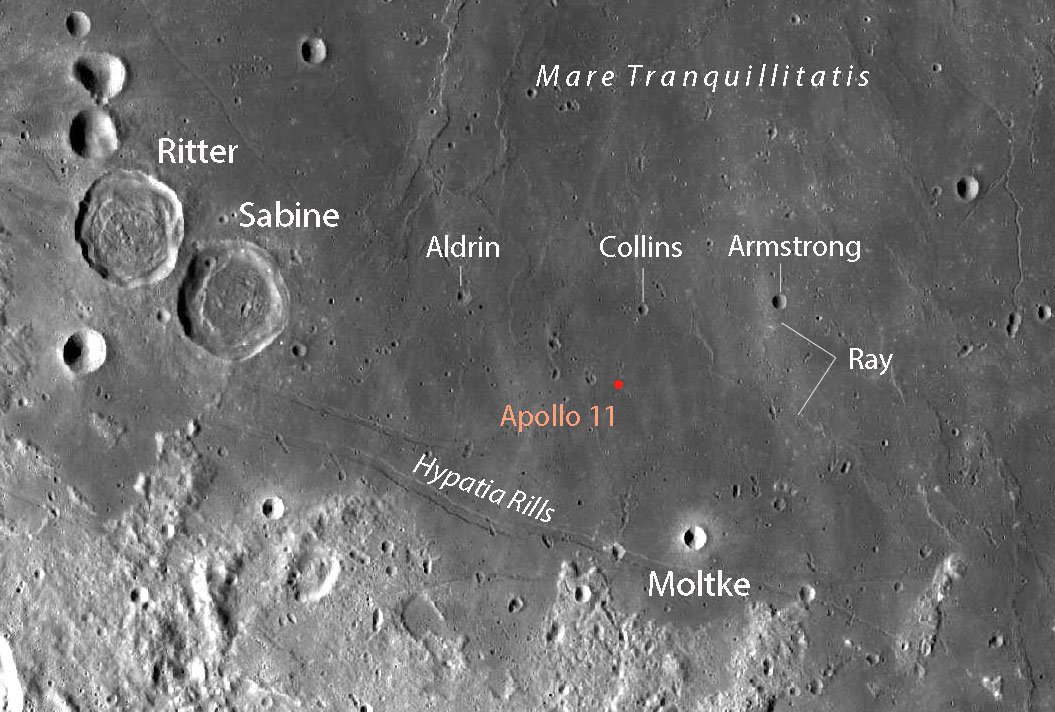
NASA / LRO / ACT-REACT
You'll appreciate that altitude because all three craters are on the small side. The Apollo 11 landing site, called Statio Tranquillitatis, is located almost due east (lunar direction) of the adjoining pair of 30-kilometer craters Sabine and Ritter along the south shore of the Sea of Tranquillity, north of the prominent, overlapping crater cluster Theophilus, Cyrillus and Catharina.
Armstrong spans 4.6 kilometers (2.86 miles), Aldrin 3.4 km and Collins 2.4 km. All are theoretically visible in a 6-inch telescope under good lighting, usually within a day or two of lunar sunrise or sunset. My observations were made with a 10-inch Dob at magnifications of 218x and 317x.
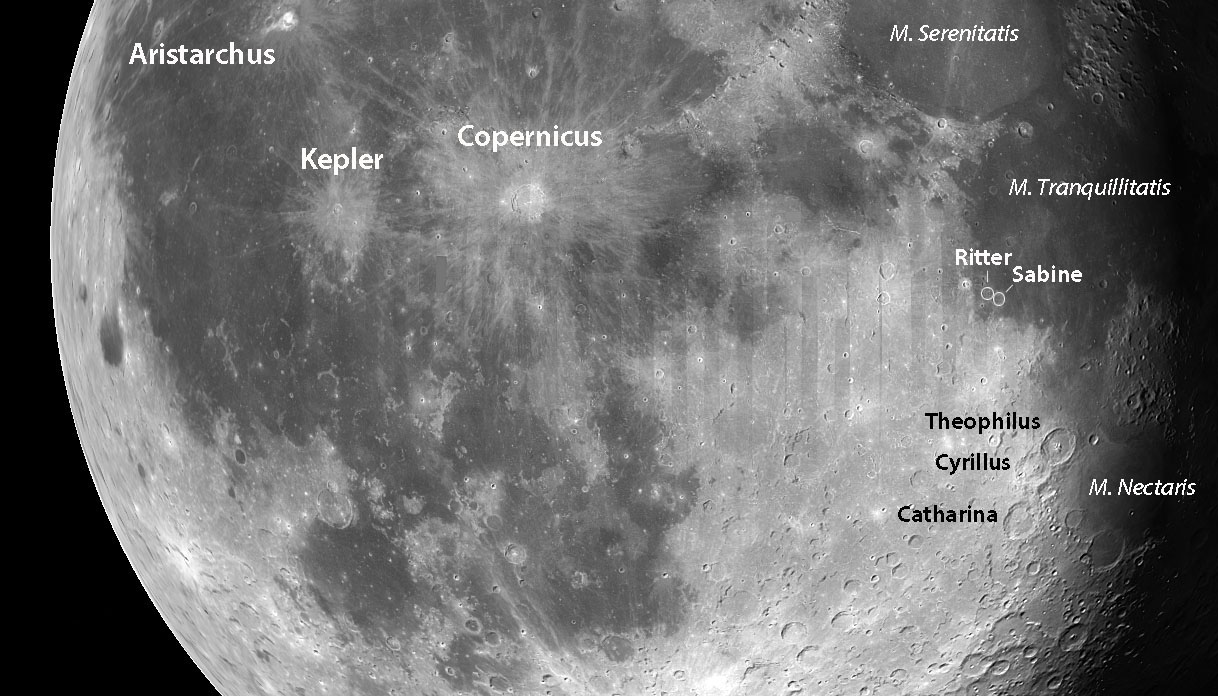
Virtual Moon Atlas
Start at Sabine and Ritter, then head east (lunar east) in the direction of the 6-kilometer-wide Moltke crater. Moltke sports a bright interior and a modest rayed halo, which makes it stand out boldly despite its small size. From there, look two Sabine crater-lengths north-northeast across a short stretch of mare for Armstrong. I had no problem seeing the crater even in so-so seeing at a magnification of 218x.
As always, seeing will be the limiting factor. If the image momentarily blurs due to unsteady air, hang in there. I always keep looking because inevitably the image will steady momentarily from time to time, offering a crisp, if brief view of the crater.
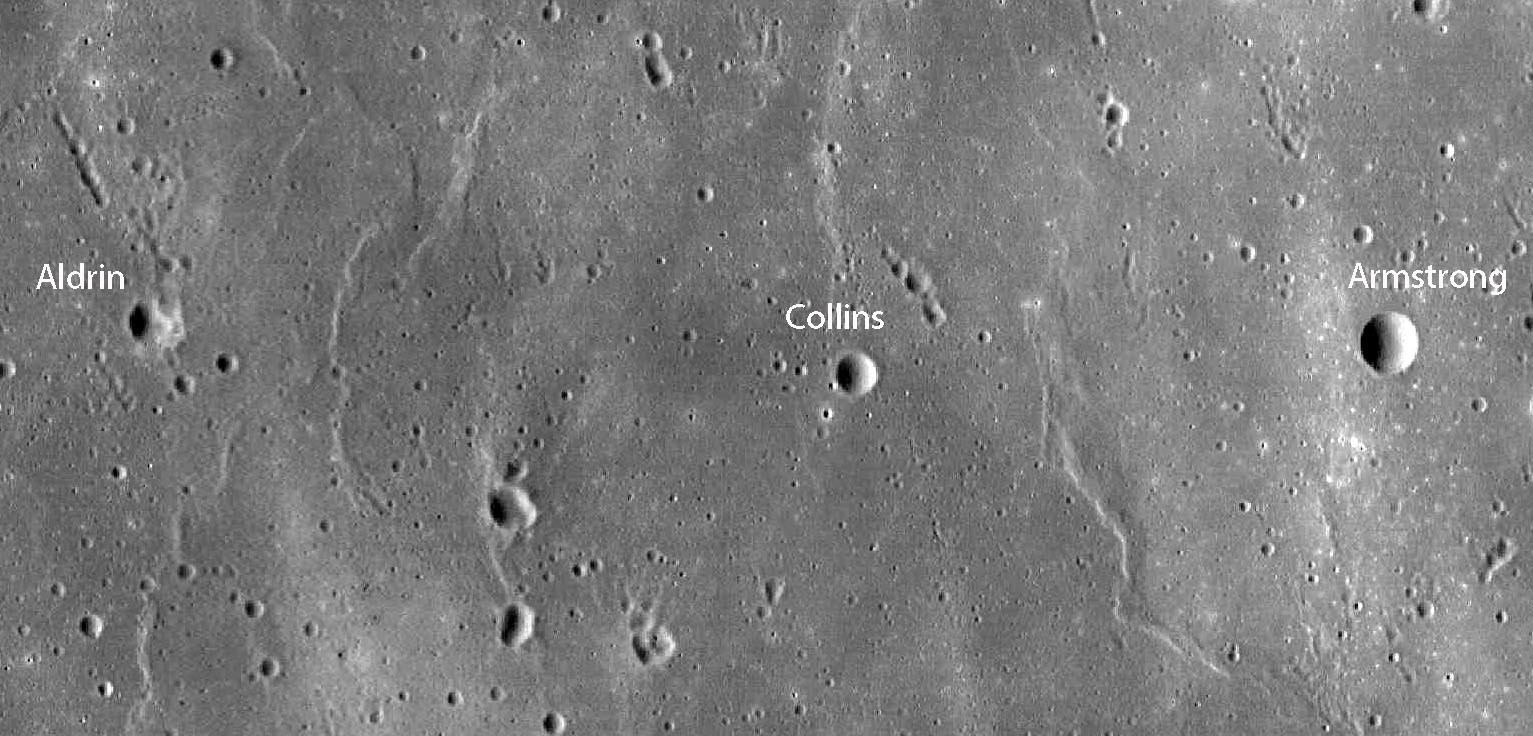
NASA / LROC / ACT-REACT
Armstrong is relatively easy to make out. For Aldrin and Collins, up your magnification to around 300x as long as seeing allows, and work back west toward the Sabine-Ritter pair. To know exactly where to look for these craterlets, it helps to connect them into a pattern with more easily seen objects. For instance, to spot Aldrin, I make it one apex of a nearly equilateral triangle that includes Armstrong and Moltke. It also lies just a bit more than one Sabine-width due east of that crater. With Armstrong and Aldrin under your belt, you're ready for Collins — the most challenging of the trio. Fortunately, it lies almost midway on a line from Armstrong to Aldrin.
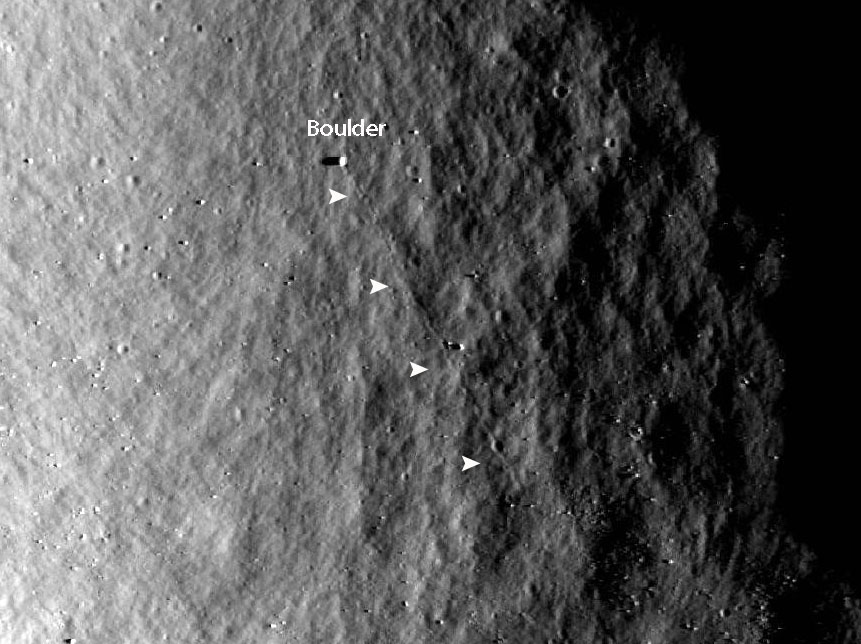
NASA / LROC / ACT REACT
Once you've become familiar with the landscape, you can pinpoint the Apollo 11 landing site itself by "triangulating" it with either Moltke and Armstrong, or with Armstrong and Aldrin. Other connect-the-dots patterns are possible, too. Under good lighting, I can just make out the U.S. flag that was blown down by the blast of the ascent thrusters on takeoff over 50 years ago.
Just kidding. But here's the thing. After you spend time tracking down the three astronaut craters, you'll become so intimate with your surroundings it'll feel almost feel like being there.
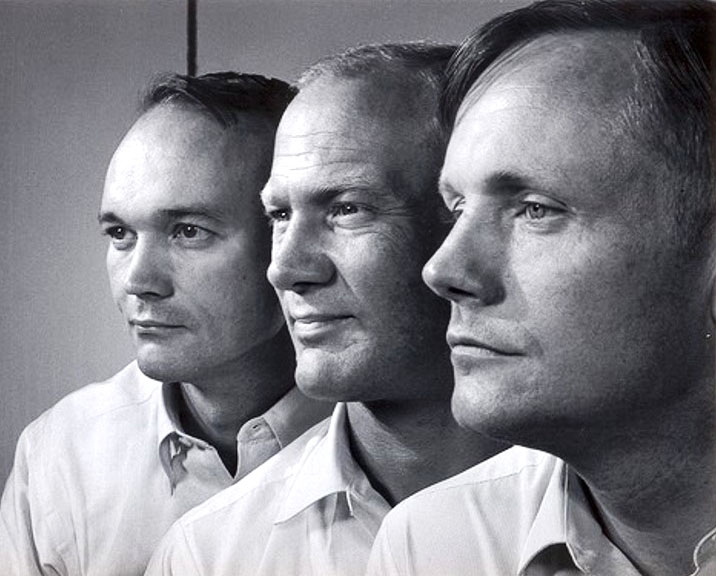
NASA
Observing Advice and Resources
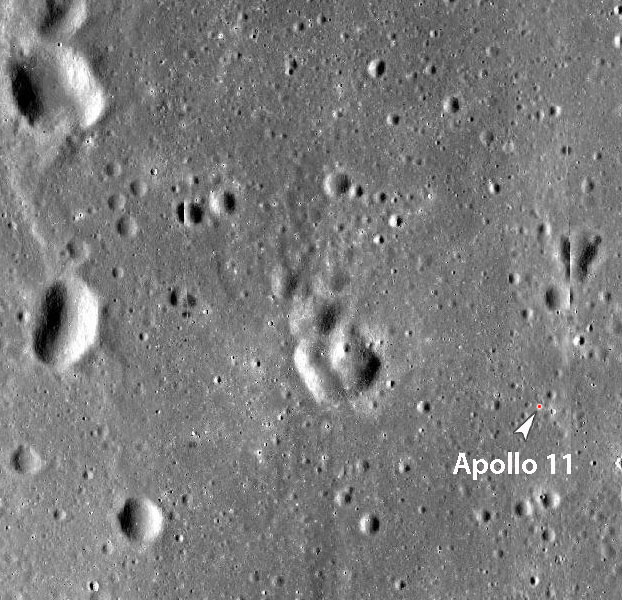
NASA / LROC / ACT REACT
Times when low-angled lighting will highlight the crater trio:
- July 21—22 before or during dawn
- Aug. 6—7 evening hours
- Aug. 19—20 before or during dawn
- Sept. 4—5 evening
- Sept. 18—19 before or during dawn
- Oct. 4—5 evening
Websites and visual bonbons:
- Interactive Lunar Reconnaissance Moon imagery
- Apollo 11 image library. Click on assembled panoramas for some incredible, lesser-known imagery
- Hans Nyberg's masterful, interactive VR Apollo mission panoramas
 9
9









Comments
Tom Hoffelder
July 18, 2019 at 5:02 pm
Now this is cool, or as they would say here in Maine, wicked cool!
You must be logged in to post a comment.
Bob KingPost Author
July 19, 2019 at 10:34 pm
Or as Austin Powers would say: "Yeah, baby!"
You must be logged in to post a comment.
Kerbal9
July 19, 2019 at 4:21 am
Thank you for article, it's great as always!
I'll try to watch at this next clear night.
You must be logged in to post a comment.
Bob KingPost Author
July 19, 2019 at 10:33 pm
Thanks, Kerbal! Let us know if you spot them.
You must be logged in to post a comment.
Rod
July 19, 2019 at 8:59 am
Bob King, enjoyed the report and images and maps. I plan to try and view the Apollo 11 area, Aldrin, Collins, and Armstrong craters tomorrow morning on the 20th, celebrating 50th anniversary. I watched that Moon landing on TV back on 20-Jul-1969, including the 16th liftoff of Apollo 11 and splash down on 24th. Shows how old I am now 🙂 Temperatures here in Maryland will be in upper 90s today and tomorrow so I plan to view the Moon near transit tomorrow morning, about 0350 EDT for my location. I was out early this morning and temps closer to mid-70s so perhaps not as bad during transit time tomorrow morning. The landing area, Aldrin, Collins, and Armstrong craters should be visible, even in my 90-mm refractor at 179x to 200x views (3 to 5 km diameter craters). The Moon is at apogee on 21st at 0000 UT or 2000 EDT so folks will need higher power to resolve those small craters. This morning during my mountain bike ride near 0700 EDT, I could see the waning gibbous Moon lower in SW-WSW sky with Mare visible - thinking of the landing while staying on the path peddling 🙂
You must be logged in to post a comment.
Bob KingPost Author
July 19, 2019 at 10:33 pm
Go for it, Rod. Good luck! Just before dawn is best.
You must be logged in to post a comment.
Rod
July 20, 2019 at 8:44 am
Bob, Rod did go for it! This morning I was out from 0200-0400. Your map of the three Apollo astronaut craters (Aldrin, Collins, Armstrong), with craters Ritter, Sabine, and Moltke is excellent. I printed a hard copy and used to view the area with my 90-mm refractor and red flash light. I was able to see Armstrong crater on the left side of Sabine crater (north up, mirror reverse view with star diagonal). Aldrin and Collins craters a bit too small to resolve at 129x views. Humidity kept me operating at 129x with about 0.56-degree true FOV. The 9-mm eyepiece I use for 200x, fogged up. However, Sabine crater, Armstrong crater, and Moltke crater framed the Apollo 11 landing site so easy to identify - with your map 🙂 There were some toads out keeping me company and an owl. I encouraged the toads to eat all the bugs they could 🙂
You must be logged in to post a comment.
bwana
July 19, 2019 at 4:14 pm
Great article BUT why the banding on several of the images?
bwa
You must be logged in to post a comment.
Bob KingPost Author
July 19, 2019 at 10:32 pm
Bwana,
Thanks! The first photo is streaked by rays from impact craters outside the frame. The wide-view image showing the gibbous moon with Copernicus, etc. is a simulation using a software program. That's just how it looks on the output probably due to stitching multiple images into one big, expandable moon. I don't know the origin of the faint horizontal banding in the "closer-in" view of the crater trio.
You must be logged in to post a comment.
You must be logged in to post a comment.